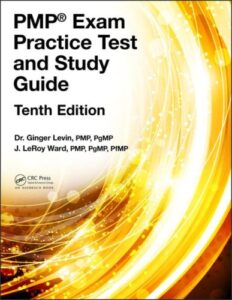PMP Exam Practice Test and Study Guide 10th Edition
PMP Exam Practice Test and Study Guide 10th Edition
The PMP Exam Practice Test and Study Guide 10th Edition contains 200 questions, of which 25 questions will not be included in the pass/fail determination. These “pretest” items, as PMI® calls them, will be randomly placed throughout the exam to gather statistical information on their performance to determine their use for future exams. The questions on the exam are distributed as follows by process group following the PMI PMP Examination Content Outline (ECO)—June 2015.
- 13% or 26 questions relate to Initiating the Project
- 24% or 48 questions relate to Planning the Project
- 31% or 62 questions relate to Executing the Project
- 25% or 50 questions relate to Monitoring and Controlling the Project
- 7% or 14 questions relate to Closing the Project
You can also read PMP EXAM Practice Test and Study Guide Ninth Edition
10th Edition Content
- Preface
![PMP Exam Practice Test and Study Guide]()
- Acknowledgments
- Online Practice Test
- About the Authors
- Acronyms
- Introduction
- Project Integration Management
- Project Scope Management
- The Project Time Management
- Project Cost Management
- Project Quality Management
- The Project Human Resource Management
- Project Communications Management
- Project Risk Management
- The Project Procurement Management
- Project Stakeholder Management
- Practice Test
- Answer Sheet
- Appendix: Study Matrix
- Answer Key
- References
There are no pretest questions in our practice exam. We also have linked each question to a specific task in one of the domains in the ECO especially since some of the questions on the PMP exam are based on the tasks in the ECO, and some tasks are not covered in A Guide to the Project Management Body of Knowledge (PMBOK® Guide) Fifth Edition.
There also are not a certain number of the scored 175 questions that you must answer correctly. PMI® explains in its PMP Credential Handbook—revised 26 June 2015, it generates a pass/fail score based on proficiency levels in the answers in each of the five process groups or domains. This approach means that you will learn whether you were Proficient, Moderately Proficient or Below Proficient in each process group.


Comments are closed.